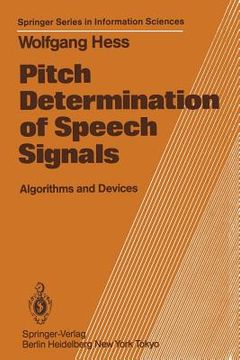Share
pitch determination of speech signals: algorithms and devices (in English)
Hess, W. (Author)
·
Springer
· Paperback
pitch determination of speech signals: algorithms and devices (in English) - Hess, W.
$ 104.20
$ 109.99
You save: $ 5.79
Choose the list to add your product or create one New List
✓ Product added successfully to the Wishlist.
Go to My WishlistsIt will be shipped from our warehouse between
Monday, July 08 and
Tuesday, July 09.
You will receive it anywhere in United States between 1 and 3 business days after shipment.
Synopsis "pitch determination of speech signals: algorithms and devices (in English)"
Pitch (i.e., fundamental frequency FO and fundamental period TO) occupies a key position in the acoustic speech signal. The prosodic information of an utterance is predominantly determined by this parameter. The ear is more sensitive to changes of fundamental frequency than to changes of other speech signal parameters by an order of magnitude. The quality of vocoded speech is essentially influenced by the quality and faultlessness of the pitch measure- ment. Hence the importance of this parameter necessitates using good and reliable measurement methods. At first glance the task looks simple: one just has to detect the funda- mental frequency or period of a quasi-periodic signal. For a number of reasons, however, the task of pitch determination has to be counted among the most difficult problems in speech analysis. 1) In principle, speech is a nonstationary process; the momentary position of the vocal tract may change abruptly at any time. This leads to drastic variations in the temporal structure of the signal, even between subsequent pitch periods, and assuming a quasi-periodic signal is often far from realistic. 2) Due to the flexibility of the human vocal tract and the wide variety of voices, there exist a multitude of possible temporal structures. Narrow-band formants at low harmonics (especially at the second or third harmonic) are an additional source of difficulty. 3) For an arbitrary speech signal uttered by an unknown speaker, the fundamental frequency can vary over a range of almost four octaves (50 to 800 Hz).
- 0% (0)
- 0% (0)
- 0% (0)
- 0% (0)
- 0% (0)
All books in our catalog are Original.
The book is written in English.
The binding of this edition is Paperback.
✓ Producto agregado correctamente al carro, Ir a Pagar.

